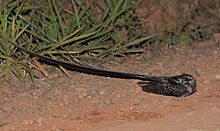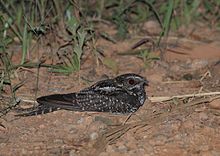| Long-trained nightjar | |
|---|---|

| |
| male at Tremembé, São Paulo state, Brazil | |

| |
| female at Tremembé, São Paulo state, Brazil | |
| Conservation status | |
 Least Concern (IUCN 3.1) | |
| Scientific classification | |
| Domain: | Eukaryota |
| Kingdom: | Animalia |
| Phylum: | Chordata |
| Class: | Aves |
| Clade: | Strisores |
| Order: | Caprimulgiformes |
| Family: | Caprimulgidae |
| Genus: | Macropsalis P.L. Sclater, 1866 |
| Species: | M. forcipata |
| Binomial name | |
| Macropsalis forcipata (Nitzsch, 1840) | |

| |
| Synonyms | |
| |
The long-trained nightjar (Macropsalis forcipata) is a species of nightjar in the family Caprimulgidae. It is found in Argentina and Brazil.
Taxonomy and systematics
Some authors have contended that the binomial Macropsalis creagra bestowed by Bonaparte in 1850 is correct, but consensus now is that the specific epithet forcipata has priority. The species' taxonomy beyond that is in flux. As of late 2024 most taxonomic systems retain it by itself in genus Macropsalis. However, based on a study published in 2023, in late 2024 the South American Classification Committee of the American Ornithological Society moved it into genus Hydropsalis.
The long-trained nightjar is monotypic.
Description
The male long-trained nightjar has extremely long outer tail feathers from which the species gets its name. It is 28 to 31 cm (11 to 12 in) long excluding those feathers, which are 48 to 68 cm (19 to 27 in) long. Both sex's upperparts are brown with spots and bars of grayish brown, tawny, buff, and cinnamon. The wings are similarly colored, with none of the white that others in family Caprimulgidae have. They have a broad tawny or tawny buff collar on the hindneck and a faint tawny patch on the throat. The breast is brown with tawny and buff bars and scallops, the belly and flanks buff with brown bars. The males elongated tail feathers have a broad white edge; the female's tail is darker and much shorter.
Distribution and habitat
The long-trained nightjar is found in southeastern Brazil from Minas Gerais and Espírito Santo south to Rio Grande do Sul and into Argentina's far northeasternmost province, Misiones. It has been recorded as a vagrant in Paraguay. It inhabits the interior and edges of primary and secondary forest and woodland. In elevation it ranges from sea level to 1,800 m (5,900 ft), and higher in the north than the south.
Behavior
Feeding
The long-trained nightjar has been recorded foraging by sallies from the ground, by hawking prey in flight, and by taking prey from leaves in flight. Its diet has not been detailed but is assumed to be insects.
Breeding
The long-trained nightjar is thought to breed between November and January in most of its range. Males make a courtship display on the ground by raising their tail in a conspicuous white "V". Eggs are laid on the ground on leaf litter without a conventional nest; the site is often shaded by a bush. The female does most of the incubation.
|
Songs and calls Listen to long-trained nightjar on xeno-canto |
Vocalization
Both sexes of long-trained nightjar make "a repetitive, high-pitched 'tsip, tsip, tsip, tsip' call."
Status
The IUCN originally assessed the long-trained nightjar as Threatened but since 2004 has rated it as being of Least Concern. It is variously rare, locally common, and common in different parts of its range.
References
- ^ BirdLife International (2024). "Long-trained Nightjar Macropsalis forcipata". IUCN Red List of Threatened Species. 2024. Retrieved 3 December 2024.
- ^ Gill, F.; Donsker, D.; Rasmussen, P. (August 2024). "IOC World Bird List (v 14.2)". Retrieved August 19, 2024.
- ^ Cleere, N. and E. de Juana (2020). Long-trained Nightjar (Macropsalis forcipata), version 1.0. In Birds of the World (J. del Hoyo, A. Elliott, J. Sargatal, D. A. Christie, and E. de Juana, Editors). Cornell Lab of Ornithology, Ithaca, NY, USA. https://doi.org/10.2173/bow.lotnig2.01 retrieved October 11, 2021
- Clements, J. F., P.C. Rasmussen, T. S. Schulenberg, M. J. Iliff, T. A. Fredericks, J. A. Gerbracht, D. Lepage, A. Spencer, S. M. Billerman, B. L. Sullivan, M. Smith, and C. L. Wood. 2024. The eBird/Clements checklist of birds of the world: v2024. Downloaded from https://www.birds.cornell.edu/clementschecklist/download/ retrieved October 23, 2024
- HBW and BirdLife International (2024). Handbook of the Birds of the World and BirdLife International digital checklist of the birds of the world. Version 8.1. Available at: https://datazone.birdlife.org/species/taxonomy retrieved August 26, 2024
- Remsen, J. V., Jr., J. I. Areta, E. Bonaccorso, S. Claramunt, G. Del-Rio, A. Jaramillo, D. F. Lane, M. B. Robbins, F. G. Stiles, and K. J. Zimmer. Version 18 November 2024. A classification of the bird species of South America. American Ornithological Society. https://www.museum.lsu.edu/~Remsen/SACCBaseline.htm retrieved November 26, 2024
- Thiago Vernaschi V. Costa, Paul van Els, Michael J. Braun, Bret M. Whitney, Nigel Cleere, Snorri Sigurðsson, and Luis Fábio Silveira (2023) "Systematic revision and generic classification of a clade of New World nightjars (Caprimulgidae), with descriptions of new genera from South America" Avian Systematics 1 (6):55–99
- Remsen, J. V., Jr., J. I. Areta, E. Bonaccorso, S. Claramunt, G. Del-Rio, A. Jaramillo, D. F. Lane, M. B. Robbins, F. G. Stiles, and K. J. Zimmer. Version 18 November 2024. Species Lists of Birds for South American Countries and Territories. https://www.museum.lsu.edu/~Remsen/SACCCountryLists.htm retrieved November 26, 2024
| Taxon identifiers | |
|---|---|
| Macropsalis forcipata |
|







